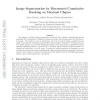Free Online Productivity Tools
i2Speak
i2Symbol
i2OCR
iTex2Img
iWeb2Print
iWeb2Shot
i2Type
iPdf2Split
iPdf2Merge
i2Bopomofo
i2Arabic
i2Style
i2Image
i2PDF
iLatex2Rtf
Sci2ools
CORR
2010
Springer
2010
Springer
Image Segmentation by Discounted Cumulative Ranking on Maximal Cliques
We propose a mid-level image segmentation framework that combines multiple figure-ground hypothesis (FG) constrained at different locations and scales, into interpretations that tile the entire image. The problem is cast as optimization over sets of maximal cliques sampled from the graph connecting non-overlapping, putative figure-ground segment hypotheses. Potential functions over cliques combine unary Gestalt-based figure quality scores and pairwise compatibilities among spatially neighboring segments, constrained by T-junctions and the boundary interface statistics resulting from projections of real 3d scenes. Learning the model parameters is formulated as rank optimization, alternating between sampling image tilings and optimizing their potential function parameters. State of the art results are reported on both the Berkeley and the VOC2009 segmentation dataset, where a 28% improvement was achieved.
CORR 2010 | Education | Mid-level Image Segmentation | Multiple Figure-ground Hypothesis | Potential Function |
| Added | 09 Dec 2010 |
| Updated | 09 Dec 2010 |
| Type | Journal |
| Year | 2010 |
| Where | CORR |
| Authors | João Carreira, Adrian Ion, Cristian Sminchisescu |
Comments (0)

